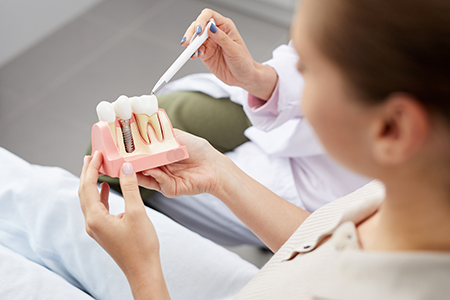Call Us Today!
(248) 863-9109
New Patients
(248) 221-2314

Tooth loss changes more than appearance — it affects how you eat, speak, and feel about your smile. Millions of adults live with one or more missing teeth, and modern implant dentistry offers a reliable way to restore function and appearance without relying on removable appliances. Our practice focuses on returning predictable results so patients can enjoy everyday activities with comfort and confidence.
Dental implants are titanium or ceramic posts placed into the jawbone to support replacement teeth. Because they integrate with bone, implants recreate the stability of a natural tooth root, allowing single crowns, bridges, or full-arch prostheses to perform much like natural teeth. This root-like support helps preserve facial structure and prevents the bone loss that commonly follows extractions.
At Royal Dental Center, we emphasize careful diagnosis and customized planning so each implant treatment is tailored to a patient's anatomy, needs, and long-term goals. Whether you’re filling a single gap or rebuilding an entire arch, modern implant options can be adapted to match your expectations for comfort, chewing ability, and aesthetics.

Unlike removable dentures, implants fuse with the jawbone through a process called osseointegration, creating a stable foundation for replacement teeth. This anchoring mimics a natural tooth root and provides resistance to the chewing forces that would otherwise stress nearby teeth or soft tissues. The result is an efficient, long-lasting solution that supports normal eating and speech.
Because implants work at the root level, they help maintain bone volume and facial contours over time. When a tooth is lost and no replacement is placed, the underlying bone can shrink, changing your bite and the profile of the face. Implant-supported teeth continue to stimulate the bone, which helps preserve overall oral health and a more natural appearance.
Implant restorations can be crafted from a range of materials to meet aesthetic and functional goals. From single ceramic crowns that blend with adjacent teeth to full-arch prostheses designed for strength and comfort, the prosthetic phase is as important as the surgical placement. Successful outcomes depend on thoughtful coordination between surgical and restorative steps.
Traditional bridges and removable dentures remain valuable options, but implants offer distinct advantages in many cases. Because implant restorations do not rely on neighboring teeth for support, they avoid the need to alter otherwise healthy teeth — a common requirement of conventional fixed bridges. For patients seeking a conservative approach to adjacent dentition, implants can be the better long-term choice.
Implants provide superior stability. When properly placed and maintained, implant-supported teeth eliminate common denture concerns like movement, slippage, or the need for adhesives. This stability improves comfort during eating and speaking and reduces the daily maintenance associated with removable prostheses.
Another important benefit is durability. While nothing guarantees lifelong function, implants frequently offer many years — and often decades — of reliable service when combined with good oral hygiene and regular professional care. Their resilience makes them a practical investment in oral health and quality of life for many patients.
Successful implant therapy starts with a comprehensive evaluation that reviews your medical and dental history, current oral health, and cosmetic goals. Radiographic imaging and, when indicated, 3D scans help assess the quality and volume of bone and identify vital anatomical structures so we can plan implant placement precisely and safely.
Treatment plans are individualized: some patients follow a straightforward pathway to implant placement and restoration, while others may require preparatory steps such as extractions or bone grafting to build a stable foundation. The plan will outline the timeline, stages of care, and options for anesthesia or sedation to ensure comfort during procedures.
Surgical placement of implants is typically performed in an outpatient setting and ranges from minimally invasive to more involved procedures depending on the case. Many patients experience little more than mild discomfort afterward, and detailed post-op instructions help support healing and reduce risk of complications.

After placement, implants require time to integrate with the bone. This healing phase — osseointegration — can take several months, though in some carefully selected cases temporary teeth may be placed immediately for esthetics and function. Final prosthetic components are fitted only once the implant is stable and the surrounding tissues are healthy.
Long-term success depends on routine maintenance. Regular checkups allow the clinician to monitor implant health, restore or tighten components as needed, and address hygiene techniques specific to implant care. With attentive follow-up and good home care habits, implants can provide durable and satisfying results.
The volume and quality of jawbone are critical to implant stability. When teeth have been missing for some time or when periodontal disease has compromised bone, grafting procedures can rebuild the foundation necessary for predictable implant placement. Bone grafts can be performed at the time of tooth removal or as a separate preparatory step, depending on each case.
Modern grafting techniques use a range of biocompatible materials to restore lost volume and shape. When combined with precise surgical planning, bone grafting allows many patients who were previously told implants weren’t possible to receive stable, long-lasting restorations instead of more invasive alternatives.
Preserving bone and maintaining healthy soft tissues around implants are ongoing goals. Good oral hygiene, routine professional cleanings, and monitoring for signs of inflammation help protect implants and the supporting structures that make them function well for years to come.
Implant dentistry blends surgical skill with restorative artistry. A coordinated approach ensures that implants are placed in positions that support both function and appearance, and that the final restorations meet your expectations. Our team focuses on thorough planning, clear communication, and evidence-based techniques to guide patients through every stage of treatment.
Whether you’re exploring implants for a single missing tooth or considering a full-arch reconstruction, our office is available to answer questions and explain which paths best align with your oral-health goals. Contact us to learn more about implant dentistry and how we can help you reclaim a comfortable, natural-feeling smile at Royal Dental Center.
If you've lost a tooth due to injury, decay, gum disease, or any other reason, we recommend dental implants to replace missing teeth. Dental implants come the closest to replicating the look, feel, and function of your natural teeth.
Dental implants are placed into the jawbone and mirror the same function as the root of a tooth. The procedure for dental implants is usually performed while a patient is sedated. Patients who undergo IV sedation must have an empty stomach and transportation home following the procedure. Most sedation patients will have little to no memory of the procedure occurring.
Generally, dental implants are made out of a biocompatible metal such as titanium. Biocompatible metals are also used for other common bone implants (such as shoulder, hip, and knee replacements). The visible portion of the implant is usually made out of porcelain and is custom-made to match your existing teeth.
Dental implants are designed to fuse to the bone, which makes them become permanent fixtures. Typically speaking, the success rate is nearly 100%. There are few cases in which the implant will not fuse as intended and must be removed. If this happens to occur, the procedure can be attempted again a few months later.
Dental implants are not usually covered by dental insurance, but may be covered under a patient's medical insurance. Our office and your insurance company can discuss coverage options with you based on your individual case and treatment plan.
It's easy... just take care of an implant as if it's a natural tooth! This involves regular brushing, flossing, and dental checkups. If you have any concerns about your implant, contact us immediately.
Dental implants are small, biocompatible posts, typically made from titanium or zirconia, that are surgically placed into the jawbone to replace missing tooth roots. Once placed, implants undergo osseointegration, a natural process where bone fuses to the implant surface to create a stable foundation. This stability supports crowns, bridges, or dentures and restores chewing function and facial support. Implant restorations are custom-designed to match surrounding teeth in shape, color, and size.
Because implants function like natural roots, they help preserve bone volume and prevent the bone loss that often follows tooth extraction. Implants do not develop cavities and reduce the need to alter adjacent healthy teeth when replacing a single tooth. Long-term success depends on precise surgical placement, proper restorative design, and regular oral hygiene. Many implant solutions also allow for temporary teeth during the healing phase when clinically appropriate.
A good candidate for dental implants generally has good overall health, adequate jawbone volume, and healthy gum tissues free of active infection. Factors such as controlled chronic conditions, oral hygiene habits, and tobacco use are considered during evaluation because they can affect healing and long-term outcomes. Advanced imaging and a thorough medical and dental history help determine whether supplemental procedures like bone grafting are needed before implant placement. Age alone is not a limiting factor; many adults of varying ages receive successful implants.
During a consultation, the practice will assess bite relationships, the position of neighboring teeth, and esthetic goals to create an individualized treatment plan. If bone volume is insufficient, bone grafting or ridge augmentation can often rebuild supporting structures to allow implant placement. When multiple missing teeth exist, implant-based options can be tailored to restore function and facial form. Treatment planning also considers prosthetic options so the surgical and restorative phases work together for a predictable result.
Implant restorations range from single crowns to full-arch solutions, and the choice depends on how many teeth are missing and the patient’s functional needs. A single-tooth implant is restored with a crown that replaces one missing tooth without altering adjacent teeth, while implant-supported bridges can replace multiple missing teeth using fewer implants. Full-arch replacement may use four to six implants to support a fixed set of teeth, providing a non-removable alternative to traditional dentures in many cases.
For denture wearers, implant-retained dentures attach to implant anchors to improve stability and retention while remaining removable for hygiene when desired. Restorations can be made from ceramic, porcelain-fused-to-metal, or other durable materials selected to match esthetic and functional goals. The restorative design is planned alongside implant placement to ensure proper emergence profile, occlusion, and long-term maintenance. Temporary prostheses are commonly provided when immediate esthetics or function is needed during healing.
The implant treatment process begins with a comprehensive evaluation, including oral exam, review of medical history, and imaging such as digital X-rays or CBCT scans to assess bone volume and anatomical structures. A personalized treatment plan is developed to determine the number and position of implants, any required preparatory procedures like extractions or bone grafting, and the type of final restoration. Surgical placement of the implant is typically performed on an outpatient basis with local anesthesia and, if requested and appropriate, sedation options to enhance comfort.
After implant placement, a healing period of several weeks to a few months allows osseointegration to occur before the final restoration is attached, although some cases permit immediate temporaries. During healing, patients receive clear postoperative instructions to manage swelling, discomfort, and oral hygiene. Once integration is confirmed, impressions or digital scans are taken to fabricate custom crowns, bridges, or dentures that are then secured to the implants for long-term function and esthetics.
Immediate recovery from implant surgery usually involves mild to moderate swelling, bruising, and discomfort for a few days, which can be managed with prescribed or over-the-counter medications and cold compresses. Most patients return to normal light activities within 24 to 48 hours, while strenuous exercise should be avoided for a week or as advised by the clinician. Proper wound care, gentle oral hygiene around the surgical site, and following post-op instructions are important to promote healing and reduce the risk of complications.
Complete osseointegration of the implant into the jawbone typically takes several months and varies by patient and site. During this period, follow-up visits monitor healing and integration before the final restoration is placed. Temporary restorations can maintain appearance and function when clinically appropriate, but patients should avoid hard or sticky foods on the surgical side until healing is complete. Long-term recovery also involves regular dental checkups and hygiene to protect the implant and surrounding tissues.
Bone grafting or a sinus lift may be necessary when the jawbone lacks sufficient height, width, or density to securely support an implant. Tooth loss, periodontal disease, trauma, or long-standing edentulism can lead to bone resorption that compromises implant stability if left unaddressed. A bone graft uses bone from a donor source, the patient, or bone substitute materials to rebuild the deficient ridge, while a sinus lift raises the sinus floor and places graft material in the upper jaw to create adequate bone height for implants.
These preparatory procedures are well-established and can significantly improve the long-term predictability of implant treatment. Healing time after grafting varies depending on the procedure and individual biology, often requiring several months before implant placement is recommended. The care team will explain the expected timeline, materials used, and any risks so patients understand the purpose and benefits of grafting in achieving a stable implant foundation.
Dental implants differ from traditional dentures and bridges primarily in how they restore function and preserve oral structures. Implants replace tooth roots and stimulate the underlying bone, which helps prevent the bone loss and facial changes that can occur with removable dentures or tooth-supported bridges. Unlike removable dentures, implant-supported restorations resist slippage and often restore chewing efficiency closer to that of natural teeth.
Compared with a conventional bridge, an implant-supported crown can replace a single tooth without preparing adjacent healthy teeth, thereby preserving natural tooth structure. Implant solutions may require surgical placement and an appropriate healing period, while bridges and dentures can be completed more quickly in some cases. The choice among these options depends on clinical findings, long-term goals, and the overall health of the remaining teeth and jawbone.
Long-term care for dental implants includes daily brushing and cleaning between teeth with floss, interdental brushes, or a water flosser to remove plaque and prevent inflammation of the surrounding gum tissue. Using nonabrasive toothpaste and a soft-bristled brush helps preserve the finish of implant restorations and surrounding natural teeth. Routine professional cleanings and exams are essential to monitor implant health, check for occlusal changes, and remove any hard deposits around the implant components.
It is also important to address parafunctional habits such as heavy clenching or grinding, which may require the use of a night guard to protect both implants and natural teeth. Smoking cessation and management of systemic health issues like diabetes support healing and long-term success. Promptly reporting any signs of bleeding, persistent soreness, mobility, or changes in fit allows early intervention when needed.
Dental implants are a widely used and well-studied treatment with high long-term success rates when placed and maintained appropriately. As with any surgical procedure, implants carry potential risks such as infection, nerve irritation, sinus complications in the upper jaw, and implant failure, though careful planning and surgical technique minimize these risks. Patient factors like smoking, uncontrolled medical conditions, and poor oral hygiene can increase the likelihood of complications and are addressed during the consultation and planning phases.
Clinicians reduce risks by using diagnostic imaging, sterile surgical protocols, and precision-guided placement when indicated. Early detection of problems through regular follow-up allows conservative management in many cases, and in the rare instance of failure, options exist for removal and site rehabilitation. Open communication with the care team about medical history and postoperative symptoms helps ensure safe and predictable outcomes.
Begin with a consultation and comprehensive evaluation that includes oral examination, medical history review, and imaging to assess bone quantity and the relationship of neighboring structures. During this visit, the clinician will discuss the range of implant-based options, any necessary preparatory procedures, expected timelines, and the recommended restorative approach tailored to your goals. A detailed treatment plan outlines surgical steps, restorative stages, and maintenance needs so you understand the process from start to finish.
Royal Dental Center offers personalized implant consultations to review diagnostic findings and answer clinical questions in plain terms so patients can make an informed decision. If implants are appropriate, the team will coordinate surgical and prosthetic phases to achieve a functional, esthetic, and long-lasting result. Scheduling a consultation is the best way to learn which implant solution aligns with your oral health and lifestyle.
Take the first step toward exceptional dental care! Schedule your appointment with Royal Dental Center today and experience personalized treatment, advanced technology, and a caring team dedicated to your comfort and oral health. Don’t wait—your best smile starts now.
